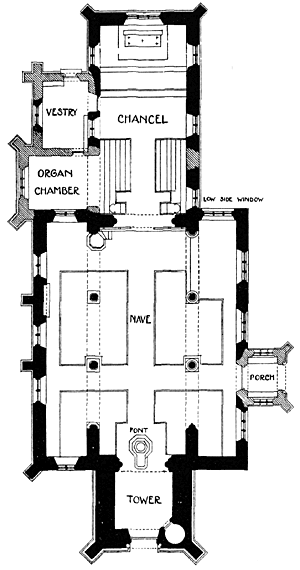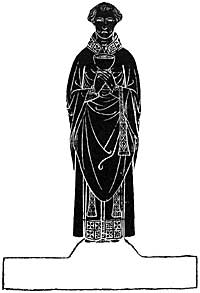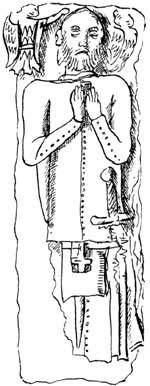Thoroton Society Summer Excursion, 1910
THE beautiful vale of the Soar was the district chosen for the Summer Excursion in 1910, and, as the day, June 7th, proved exceptionally fine, and the churches to be visited were of much interest, a goodly number of members and friends attended. The party numbered about sixty, and included the Mayor of Nottingham and Mrs. Ball, Alderman R. Mellors, Councillor E. Mellor, Mr. George Fellows; the Revs. A. M. Y. Baylay, F. W. Mosley, W. Laycock, E. Hodgson, J. Standish ; Major Morgan, Messrs. J. Granger, J. H. Haywood, W. R. Hamilton. H. Gill, W. S. Ellis, G. F. Gascoyne, F. N. Smith, J. W. Windley, G. E. Hore, J. Selby, J. R. Anderson, A. Stapleton, T. Anderson, F. A. Wadsworth, J. Ward, H. Wyles, and H. Hill.
Leaving Nottingham a few minutes before 9 a.m., by the Midland Railway, the party reached Loughborough about 9.30 a.m. The rest of the journey was done in brakes, lunch being provided at the Plough Inn, Normanton-on-Soar, and tea at the Station Hotel, Kegworth. The churches visited were seven in number, viz.:— St. John Baptist's, Stanford-on-Soar, St. Mary's, Normanton-on-Soar, St. Helena's, West Leake, St. Wilfrid's, Kingston-on-Soar, Holy Trinity, Ratcliffe-on-Soar, St. Michael's and St. Anne's, Sutton Bonington. Some of the members also visited Repton Grange, a house known by the ominous title "Hobgoblin," and supposed, though we cannot vouch for the fact, to have been formerly a cell of the Canons of Calke, a subordinate cell of Repton Priory, transferred to Calke in 1172.
The following notes and papers, some of which were read on the day of the excursion, deal respectively with the churches visited.
ST. JOHN BAPTIST, STANFORD-ON-SOAR.
BY THE REV. C. L. VASHON BAKER.
The following paragraph is extracted from the church register:—
"In the year 1882, July 2nd, the church was re-opened after the removal of the old pulpit, reading and clerk's desks, pews, the raised Dashwood family pew over the Dashwood vault, and the substitution of open pitch-pine seats. There was also a new flooring with wooden bricks put down and the old pulpit was altered and used again. The rector having paid all the expenses of re-seating, flooring, etc. etc., also substituted the present hot-water heating apparatus for the former solitary stove."

The old pulpit, apparently a three-decker, stood on the south side of the eastern pier of the north arcade, the preacher facing south. The old pews—made of deal—were used by the rector, in 1882, as panelling for one of the rooms at the parsonage. Rough deal benches, about 3ft. long, had been used up to 1882 in the middle gangway by the school children, and two of these benches, for some years after the restoration mentioned in the register, took the place of trestles for the coffin at funerals.
The following is a description of the church as it stood in 1887:—
It comprised a nave of three bays with a lofty 15th century clerestory. The roof, also 15th century, was "beautified—adorned" with paint in imitation of marble! Carved oak figures stood on corbels under the principals, yellow colour-washed! There was a figure, apparently of an archangel blowing a trumpet, on a bracket over the apex of the chancel arch, and another like it over the apex of the western arch of the nave. The piers of the arcades— both north and south—were cylindrical with capitals in plaster, ornamented with acanthus leaves; those on the south side being considerably above the spring of the arch. The pulpit, a modernised 17th century one, was of deal, painted and varnished. The font of stone, 17th century, remarkably small, with no drain, on a circular step, painted to imitate marble, stood to the east of the tower arch. In the south aisle a modern doorway led direct from the churchyard, and in the north aisle, at the west end, was a wooden erection —part of the restoration of 1882—used as a vestry. The nave floor was laid with 18th century glazed tiles, 6in. below the outside level, and the same below that of the chancel. The walls of the chancel were panelled with painted deal, about 4ft. high, in a very dilapidated condition. A flat white-washed ceiling, enriched at the eastern portion with a large wreath in the centre, and a cherub at each corner of a square, was over the sanctuary. The floor was paved for the most part with monumental slabs in slate. There was a modern "Priest's Door" on the south side, about 10ft. to the rear of the chancel arch. The walls throughout the church were plastered and white-washed. The altar cloth, candlesticks, and vases had lately been provided by Mr. Robert Dashwood, who was rector in 1882.
In 1893, Mr. Richard Ratcliff, who had bought the Stanford Estate from the Dashwoods some six years before, invited Mr. W. S. Weatherley, of Cockspur Street, London, to report on the condition of the church, and advise as to its further restoration. In due time the report was made and accepted, and the work given to Mr. John Thompson, of Peterborough, to carry out. As it was computed that the restoration would require about eighteen months to complete it, a temporary iron church was erected on a piece of ground to the east of the church, which was finally consecrated and became an addition to the churchyard.
The work was begun early in 1893, and comprised the following details:—
 MONUMENTAL BRASS, STANFORD-ON-SOAR. From " Monumental
Brasses of Nottinghamshire. —Briscoe and Field.
MONUMENTAL BRASS, STANFORD-ON-SOAR. From " Monumental
Brasses of Nottinghamshire. —Briscoe and Field.The chancel, which was found to be insecure (the walls being two skins of rubble without bond, filled up with what was once "grouting," and had now become dust) was re-built, new foundations being laid, on the exact lines of the old ones. The walling stone used was Whatstandwell, and all the old ashlar, as far as possible, used again. In scraping the plaster from the wall a small doorway was discovered on the north side, which led apparently into an ancient vestry, or Priest's Chamber (the foundations of which were found when excavating for the new vestry). On the south side the drain and basin of the piscina were restored, and about 18ft. from the east wall a small square aumbrey or locker was discovered, also near the chancel arch in the same wall a good specimen of a "low-side window" with the hooks for the hinges of the wooden shutter and the eye for the bolt still in their places. This window had evidently been walled up in pre-Reformation days, as the masonry was thoroughly good. Near this "low-side window," slightly to the east of the east jamb of the window, may be seen the outer edge of the splay of a former lancet light. This fact points to an Early English chancel.
In the north wall an opening with a simple arch was made into the new organ chamber. On the south side of the east wall a square aumbrey was uncovered, which in rebuilding was placed in its former position. The pitch of the roof was raised, and the east window (which had been filled with stained glass by the Dashwood family) was also considerably raised. The plaster ceiling gave place to the panelled oak roof, which gives great dignity to the chancel. The floor was paved with black and white quarries of marble, and the sanctuary with white, verde antique, and rocco antique. The choir stalls, organ case, triptych, and altar rails are excellent in general form, and rich—without being overladen—in detail. The wall of the chancel was plastered and painted in preparation for decorations, the designs for which were made by Mr. Chas. Powell, of Hatton Garden, London (and were approved by Mr. Weatherley). This work, which was at one time on the eve of being undertaken, was unexpectedly countermanded. The window in the vestry was originally in the north wall of the chancel, in the position occupied now by the organ chamber arch. The organ was built by Hy. Willis, of Camden Town; the case designed, of course, by the architect. There are interesting monumental slabs in the chancel:—On the south side a brass for a priest of the 14th century, and on another slab the matrix of a brass representing the Holy Trinity. On the north side an incised slab to the memory of an Illingworth.

Effigy, Stanford-on-Soar.
The work in the nave consisted in cleaning all the ashlar of whitewash and removing plaster from the piers. It was found that originally those on the south side were cylindrical and those on the north octagonal. The spring of the arches on the former being considerably higher than that on the south side. This, apparently, was unpleasing, and not to be endured by the church "restorers" of the 17th century. Accordingly they carefully cut off the capitals, supplying in their place capitals of plaster, taking care to make them the same height from the ground on both sides of the nave. This meant that the capitals on the south side were considerably above the springs of the arches. In order to make the octagonal shafts "match" those on the other side, brickbats also had been carefully built round them, and the whole covered with plaster. On "stripping," the shafts on both sides were found as usual to have been mercilessly hacked to give "key" to the plaster. It was suggested that their surface should be dressed back only five-eighths of an inch in diameter, in order to give a smooth face. This was accordingly done. But a few days later the foreman, noticing some thin dark marks on the new face of the stone, examined them, and found that they were cracks! The 5/8in. diameter could not be spared. Both arcades were on the point of falling ! It was necessary to collect all the workmen together and shore up both arcades that very evening. The shafts were then rebuilt. It was most fortunate that a small portion both of the capitals and bases of both arcades was found, so that they could be accurately reproduced. The bases of the tower arch had been cut away, but again the contour waS traced in the wall against which the base had abutted : so that it could be reproduced. The nave roof had been repaired in the end of the 17th century. The principals had evidently perished where they rested on the walls—these had been cut off, and the principals used again, so that the pitch of the roof had been considerably reduced. The whole roof was painted in imitation of marble! Wooden figures, which had probably stood originally in niches, were placed on corbels only and colour-washed yellow. The roof was now thoroughly overhauled, the original pitch was restored, suitable niches provided, and the figures carefully cleaned of their unsightly coating. In the north aisle, the canopy of the recumbent figure was restored. Of this figure I can get no information as to its history. It seems to puzzle antiquaries. In the village it used to be called "The Indian." It appears to me to have been "dressed over" by some village mason; compare the acorns and oak leaves (untouched) and the neck, hands, and face of the figure. In the south aisle the modern doorway was taken away, and another in character with the rest of the architecture was built a few inches more easterly, in order to get the centre between two windows. The east window of this aisle had in the 17th century been entirely closed up by the monumental tablet of a Lewes. This was removed, by virtue of a faculty, to the west end of the same aisle. The floor of the nave, both aisles, and the space under the tower were laid with narrow oblong red tiles. A new porch was built outside the south door. And it is a matter of great interest that when the earth was excavated for the foundations, those of an original porch were discovered exactly the same size as that which was about to be built.
The old font—mean and impractical—was broken up to prevent its ever being used for a flower-pot in the rectory garden, and was buried in the churchyard. The new font— very stately in design, but rather spoiled by the material of which it is made—stands exactly in the same spot as its predecessor.
There is a small niche above the piscina above the Dashwood vault (which clearly was once a chantry chapel), and another still smaller on the pier behind the pulpit. What these small niches were no one can positively say.
The tower staircase was renewed where it was needful, and the ringing chamber re-floored and panelled. Two of the old bells being cracked were re-cast, and the two others quartered : two new ones—one a tenor—were added. Iron frames were substituted for the old oak ones. The work was carried out by Taylor, of Loughborough.
A flag-staff was placed on the tower: and vanes on the four pinnacles.
The gable cross on the chancel is modelled on a large fragment dug out of the ground just outside the east end of the chancel. It is assumed that the fragment discovered was part of a cross which had stood on the east gable.
The stone balls which crowned the masonry above the clerestory were replaced by simple pinnacles: and all the really defective ashlar work throughout was restored.
There is a part of a 14th century doorway in the north aisle, partly blocked up by a window which, at first sight, seemed to be of the same period. But on careful examination it proves to be a late 17th century copy of the other 14th century window in the same wall. Notice the vertical joint in the quatrefoil, and the flatness and breadth of the fillets.
The lychgate is entirely modern—an excellent example of timber work.
In the "Jubilee Year," 1897, a clock with Cambridge chimes was given to the church by Mr. Richard Ratcliff, together with two additional bells—seventh and treble— bringing up the number to eight.
The brass lectern—poor in design and execution—had been bought by subscription several years before the restoration of the church, and remains in use until a more worthy one shall be provided.
The stained glass in three windows on the south side of the chancel—one on the north side—two in the north aisle— one to the west of the south door, is the work of Charles Powell, that in the west window of the tower—Clayton & Bell's, the east window and that over the Dashwood vault— Lavery & Westlake's. These last are very poor.
Most of the monumental tablets on the floor of both chancel and nave were buried in situ; but a plan of their positions has been made, and the inscriptions recorded and the record preserved.
In 1889, the 17th century chalice being found inconvenient for use for the reverent administration of the Holy Sacrament, was re-cast from the design furnished by W. S. Weatherley, Esq., architect. A record of this fact has been made in the register of the parish, together with drawings, etc., of the chalice; the paten was also altered, the sacred monogram being transferred from the underside was inserted on the face, in place of the crest of the donor, Lewes. For this we are found fault with by ardent antiquaries: but there was no real beauty in the original design, and the impractical shape of the chalice and the unseemly ornament of the paten condemn them on the ground of reverence.
The church was re-opened on May 24th, 1894 (the Queen's birthday, and also Mr. Ratcliff's), the addition to the churchyard was consecrated and the sermon at matins preached by Dr. Ridding, Bishop of the Diocese. The preacher at evensong was the Rev. F. Hicks Beaven, St. Paul's, Burton-on-Trent.
In the churchyard, at the south side of the tower, in digging a grave, tesselated pavement was discovered about 4ft. below the surface; and again at a later date, about 4ft.further south, another part of the same pavement was again laid bare. The tesserae were stone—grey, blue, and white.
There is a tradition connected with the fine yew tree in the churchyard, that King Charles the Martyr, when taking refuge with Henry Skipworth at Cotes, walked over to Stanford with him, and they sat beneath the yew tree discussing the affairs of the kingdom. I hope to be able in some way to discover the ground for this tradition, which, if it be true, adds a peculiar interest to this very fine tree.
The next halt was made at Normanton-on-Soar, where the following paper was read by the vicar of Thurgarton.
